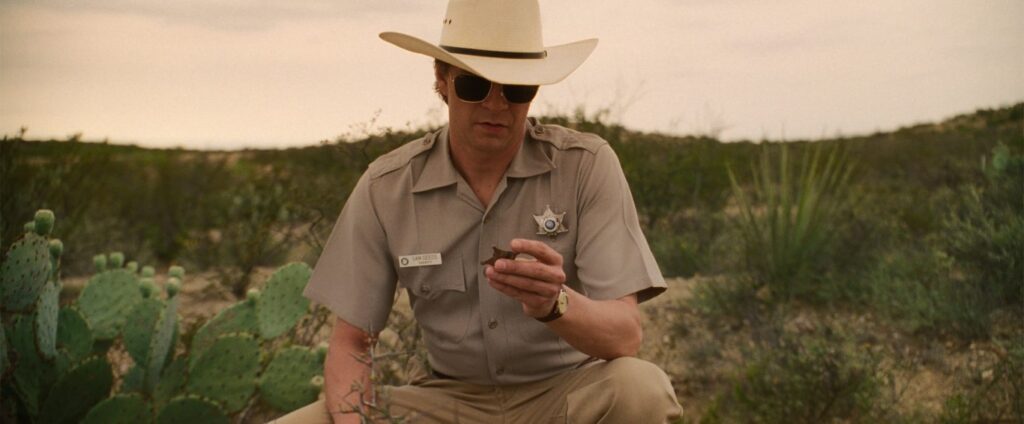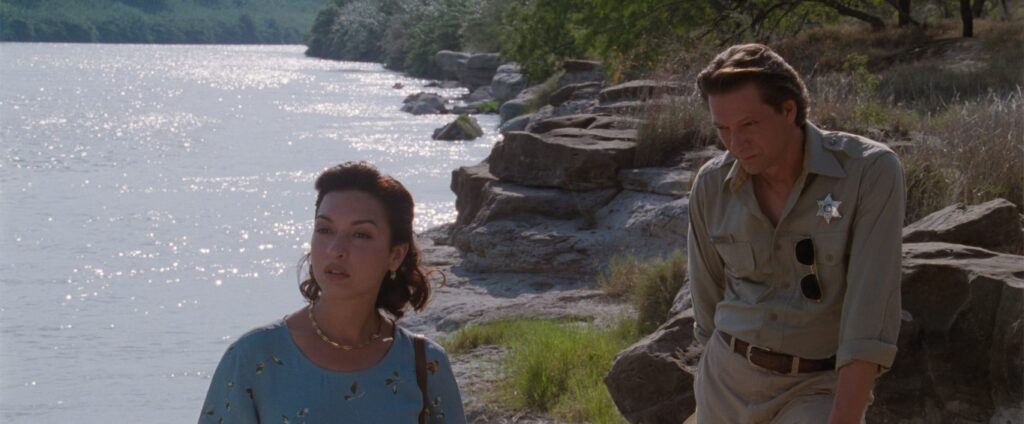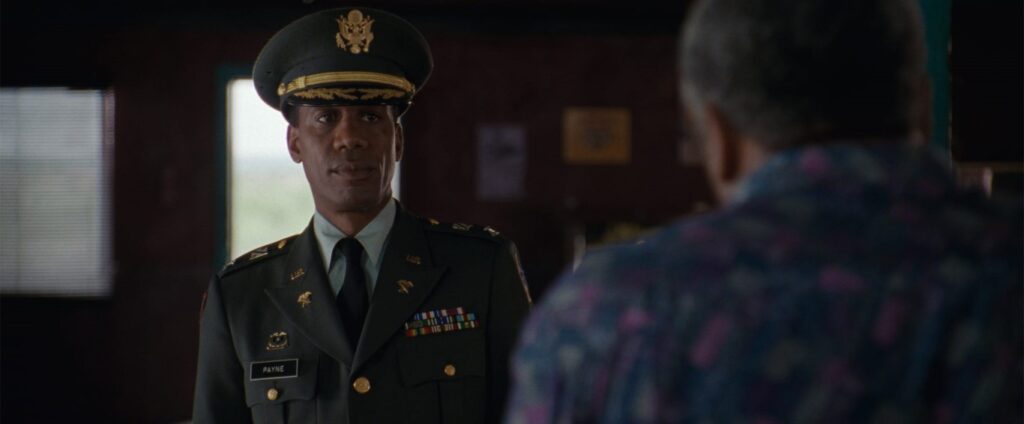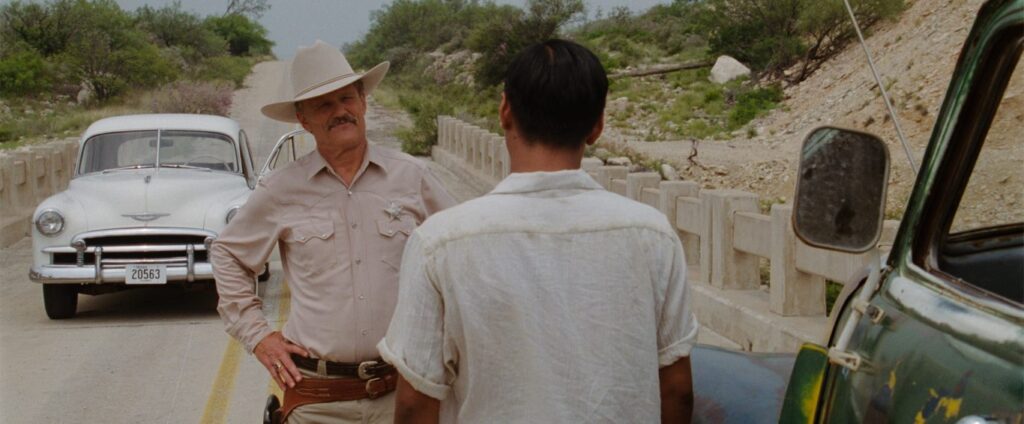The acclaimed filmmaker looks back on his most celebrated work as it enters the Criterion Collection.
Originally released in 1996, Lone Star, the 10th feature film from celebrated American independent filmmaker John Sayles, tells a story set in a small Texas town on the U.S.-Mexico border. The local Sheriff, Sam Deeds (Chris Cooper), lives in the shadow of his father, legendary former Sheriff Buddy Deeds (a pre-stardom Matthew McConaughey). According to town legend, murdered his predecessor in the position, the monstrous Charlie Wade (Kris Kristofferson), while serving as his deputy and took over his job. When it appears that Wade’s long-vanished remains have been uncovered in the desert, Sam ignores those who prefer to leave the whole thing buried and begins to investigate what happened all those years ago. The revelations shine new light on the history of the town and his relationships with his father and the former high school sweetheart (Elizabeth Peña) his parents forbade him to see.
Using the tropes and the iconography of both the mystery and Western genres, Sayles told an engrossing narrative that examined our tendency to print the legend over the truth can continue to bear poisonous fruit.
Fitting a film of its status, Lone Star is now entering the Criterion Collection with a brand-new 4K UHD edition featuring a new transfer, a filmed conversation about the film and its legacy between Sayles and Gregory Nava, and an interview with cinematographer Stuart Dryburgh.
Sayles sat down with The Spool via Zoom to talk about how the issues raised by the film have stayed the same over the years, what would change if it were made today, and his misadventures in trying to bring the historical truth to the Hollywood machine.
This interview has been edited for length and clarity.
Lone Star has gone on to be one of the standouts in your career as a filmmaker—it received rave reviews, earned an Oscar nomination for your screenplay, and was a commercial success to boot. What did the film represent to you as a filmmaker at the time that you made it, and looking back on it nearly 30 years later?
JOHN SAYLES: Certainly it was the movie where we had the most support from the people who financed it. Castle Rock spent a lot of time and money pushing the movie into theaters and doing good advertising to get it out there. It is the most seen of any of our movies in terms of seeing it when it first came out because, quite honestly, they spent more money on ads and it ended up making them some money and us some money.
Today, what I think is interesting, almost in a sad way, is how many of the issues in the film are not resolved. The scene where the teacher is talking to the parents about how history is taught in Texas schools—that has gotten worse if anything, the idea that we have to protect people from learning what really happened.
The border is harder and more heartless than it used to be. When we were there, you took a dime, put it in a slot and you went through a turnstile, and had a margarita or whatever. The Mexican people could do the same and go up to Wal-Mart and buy something they couldn’t get on their side and go back. Now there’s a wall. At one point, we were putting barbed wire up in the middle of the river and people trying to cross were getting hung up on it.
The symbolic nature of that border means, quite honestly, more to certain politicians and the people who vote for them than it does for the people who live on either side of it and who have pretty good relationships with each other. But it’s sadly gotten worse.

When movies age, you have to think about how they will play today. There are some old movies that I see where I have to think “Well if you take out the racist stuff, it’s still a Marx Brothers movie.” This one, I think, holds up fine, but one of the reasons is that we haven’t made much progress. When we made it, the narco stuff was strong in Laredo and strong in El Paso and all the towns in between didn’t have to worry about it.
I actually played a border patrol guy in the movie, so I got to talk to the local border patrol guys. Tey said that where we were wasn’t a hotspot, but people were trying to come over all the time. What they said the most was “Don’t make me run.” They would roll their windows down and the people would come over, they would make sure that none of them were wanted for crimes in the U.S. and then drive them back across the border in a van and let them out. Nobody was wearing body armor.
Now, if you’re a border patrol guy, you have to wear body armor because you never know when you are going to come across someone packing an automatic weapon. I couldn’t make the movie honestly today without including the drug trade.
Considering the complex and multi-layered nature of the story being told, what was the initial idea that eventually led to Lone Star?
I had always been kind of fascinated with the legend of the Alamo. I had seen the Davy Crockett version on Disney when I was a kid and then the John Wayne version in 1960. Then, as I got to know more about what was actually behind the Texans deciding to break away from Mexico, I realized that this was a very finely tuned and specific legend that left out a lot of the complexities. I started thinking about what happens when legends become destructive.

I was writing it at a time when the former Yugoslavia was breaking apart. You were seeing people being interviewed from one side to the other and all that awful ethnic cleansing was going on. They would say, “Well, those people stole our land back in 1300” or “They massacred a bunch of our people back in 1200.” I was thinking, “My God, these are just stories by now that you’ve carried in your culture, and you’re killing each other over these stories.” It was so rarely something that had happened today—these were legends that had become destructive. It could be animus between two different religions or past wars between people of two different classes in India.
I started thinking about American legends—which ones were still useful and which ones were now destructive. There is the romance of the antebellum South, a legend that was destructive for a long time—I’ve spent a long time in the South, and I’m glad that people are not flying the stars & bars anymore. I found that offensive and I’m white. It took a long time but as generations passed on, I think people finally began to get to the point where they recognized that some people whose ancestors had been enslaved might object to this. I wanted to go into an area where there were these legends both on a family and community level. People are still honoring these legends, and most people of a certain age know that they are not true but they continue to believe in them and teach them.
Didn’t you at one point work on a screenplay about the battle at the Alamo for Ron Howard?
Yeah, and it eventually got made, though not by Ron. I wrote the first draft, I believe, when Ron was going to do it. When they did the test marketing for the film they eventually made by John Hancock, a lot of the responses said that it was too long and too multi-cultural—they should have seen my version. I would say that the only thing left of my particular hit on it is that at some point, I told them, “You know, this is like Custer’s Last Stand where everybody gets killed. We can’t change that. But if you want to have the Texans win at the end, you have to go all the way to the Battle of San Jacinto.” That was in my first script. John Hancock rewrote it quite thoroughly, so I didn’t ask for credit on it.
Ron eventually stepped away from it and you would have to ask him why—it may have been because the vision he had for it was going to cost a certain amount of money and the studio got nervous about that and decided to back off on the cast that they had so as not to spend too much. Of course, they did wind up spending that much by the time it finally came out. Disney decided to do it right after 9/11–they said they wanted to do some celebratory American movies. They offered me three historical incidents and I told them “I know those incidents and there is not a lot to celebrate in those.” The story of the Alamo had some interesting stuff that you could get into and there were absolutely some moments of heroism, even though what they were fighting for was the freedom to own slaves.

In a number of films, you have utilized familiar film genres as an entry point for the narratives you tell — sci-fi with The Brother from Another Planet, the sports film with Eight Men Out. With Lone Star, you use two genres as the framework for your narrative—the mystery/detective story and the Western. How did you come across using those two genres and their respective tropes and iconography to tell your story?
Whenever you even come close to a genre, you have to be aware that people have preconceptions and that can be a plus or a minus. Sometimes they can lock you in a little bit. But in our case, they helped get us our biggest audience ever, because they saw a badge and a hat and boots and thought that it looked like a Western, which made them comfortable.
You have to be aware of what people expect when you work within a genre. If you’re going to change anything, you had better be pretty good at preparing people for that change. Or you better realize you are going to lose some people because this is not going to be the kind of Western they think they’re going to see.
I have a very small part in Jonathan Demme’s Something Wild and as that film starts, there’ i’s a kooky girl and a straight guy, an Owl and the Pussycat-type story. When I was watching it, I was thinking that it was going to lose some energy because I didn’t think they could sustain it. Then Ray Liotta shows up and suddenly, you think that someone could get killed here!
I talked to Jonathan about it later and he said that was his intention. However, I bet there were a lot of people who said, “You can’t do that. I was having such a nice time hanging out with the kooky girl and the straight guy—now I have to sweat and worry about what is going to happen.” It’s something you are always aware of. Very often in my movies, you get something that could be a good straightforward genre movie where I want to recognize the complexities of the situation. The minute you start to get complex, you start to get away from simple black hats and white hats, which is what Westerns had always been built on.

The casting in this film is particularly interesting. In the main role of Sam, you have Chris Cooper, who had only done a few films, many of them yours, at this point in his career and mostly in supporting parts. Then you have Kris Kristofferson, who, as a movie star, might have plausibly played Cooper’s part but is instead playing perhaps the most hateful and irredeemable character to be found in all of your films. Then you have Matthew McConaughey, who became a big star the summer that Lone Star came out, but who at that time was known almost entirely for his turn in Dazed and Confused.
It tells you something about the changes in the movie industry that today, there’s no way that we could have cast somebody like Chris Cooper at that point in his career. His first movie was Matewan and he was the lead in that; it was a miracle that we were able to make it with someone who was the right actor, but not well-known, in the lead. Castle Rock liked the script and kind of trusted me to put good people in it. Kris Kristofferson had been in a couple of big hits like A Star is Born, but hadn’t been in one recently. I was trying to think of the Texan actors. Kris had grown up on the border and I had never seen him play a bad guy before—he has those small eyes and that deep voice that makes you think that he could be a really scary bad guy if he wanted to.
With Matthew McConaughey, I knew Rick Linklater a little bit and saw Dazed and Confused; one of the things I liked about that the most was that laid-back good-ol’-boy. Rick knew him as a film student and gave him a little part, but he was so charismatic that he started expanding it. We had him come in to read and it was like, this guy is from Uvalde, Texas and he can have a confrontation with Kris Kristofferson that can seem qual and tense even though he never stands up. The day we saw him, we told him that he had the part. It was clear that this guy was going to be around.
Except for Baby, It’s You, all of your films have been independently produced and distributed, in many cases by entities that no longer exist. In the case of Lone Star, which was produced by Castle Rock, I assume that it was relatively easy to put together a project like preparing Lone Star for this Criterion release. How complicated would it be if you wanted to do a package like this for one of your other films?
When we first started to try to get the rights to Matewan back, it took us a year to find out who actually owned it, because companies had gone out of business and sold their libraries to other companies that also went out of business. We approached MGM and informed them that they had the rights to the movie and they said, “No, we don’t.” It took us several months to convince them to look in their records and they finally realized, “Oh yeah, we do,” which meant that they were not planning on doing anything with it.
Now there is a copyright law and if you are a writer-director-editor, you have a clear line to come to people after 25 years or so and tell them that the copyright is reverting to us. That’s what we’re trying to do with a bunch of movies, but there are a lot of filmmakers who have no idea who owns their movies anymore. I say that you should just arrange a screening and advertise that you’re going to charge admission. Maybe someone will come to sue you and you can at least figure out who owns it.
Lone Star is now available on 4K from The Criterion Collection.
Read next: The Spool's Best New Releases
Streaming guides
The Best Live TV Streaming Services With Free Trial
The praises of live TV streaming services don’t need to be further sung. By now, we all know that compared to clunky, commitment-heavy cable, live TV is cheaper and much easier to manage. But just in case you’re still on the fence about jumping over to the other side, or if you’re just unhappy with ... The Best Live TV Streaming Services With Free Trial
How to Watch Power Book III: Raising Kanan Season 3
Season 3 of the hotly anticipated Power spin-off, Power Book III: Raising Kanan, is arriving on Starz soon, so you know what that means: it’s the ’90s again in The Southside, and we’re back with the Thomas family as they navigate the ins and outs of the criminal underworld they’re helping build. Mekai Curtis is ... How to Watch Power Book III: Raising Kanan Season 3
How to Watch Doctor Who: 60th Anniversary Specials
Ladies and gentlemen, we’re so back! To celebrate Doctor Who’s 60th anniversary, the BBC is producing a three-episode special starring none other than the Tenth/Fourteenth Doctor himself, David Tennant. And to the supreme delight of fans (that would be me, dear reader), the Doctor will be joined by old-time companion Donna Noble (Catherine Tate) and ... How to Watch Doctor Who: 60th Anniversary Specials
Which Netflix Country has Interstellar?
Maybe you’ve just seen Oppenheimer and have the strongest urge to marathon—or more fun yet, rank!—all of Christopher Nolan’s films. Or maybe you’re one of the few who haven’t seen Interstellar yet. If you are, then you should change that immediately; the dystopian epic is one of Nolan’s best, and with that incredible twist in ... Which Netflix Country has Interstellar?
Which Netflix Country Has Each Movie of The Hunger Games?
For whatever reason, The Hunger Games series isn’t available in the same countries around the world. You’ll find the first and second (aka the best) installments in Hong Kong, for instance, but not the third and fourth. It’s a frustrating dilemma, especially if you don’t even have a single entry in your region, which is ... Which Netflix Country Has Each Movie of The Hunger Games?
How to Watch ESPN With A Free Trial
One of the major concerns people have before cutting the cord is potentially losing access to live sports. But the great thing about live TV streaming services is that you never lose that access. Minus the contracts and complications of cable, these streaming services connect you to a host of live channels, including ESPN. So ... How to Watch ESPN With A Free Trial
How to Watch Paramount Network With a Free Trial
To date, Paramount Network has only two original shows on air right now: Yellowstone and Bar Rescue. The network seems to have its hands full with on-demand streaming service Paramount+, which is constantly stacked with a fresh supply of new shows. But Yellowstone and Bar Rescue are so sturdy and expansive that the network doesn’t ... How to Watch Paramount Network With a Free Trial
How to Watch WE TV With a Free Trial
Previously “Women’s Entertainment,” We TV has since rebranded to accurately reflect its name and be a more inclusive lifestyle channel. It’s home to addictive reality gems like Bold and Bougie, Bridezillas, Marriage Boot Camp, and The Untold Stories of Hip Hop. And when it’s not airing original titles, it has on syndicated shows like 9-1-1, ... How to Watch WE TV With a Free Trial
How to Watch TNT Sports With A Free Trial
For many sports fans, TNT is a non-negotiable. It broadcasts NBA, MLB, NHL, college basketball, and All Elite Wrestling matches. And, as a bonus, it also has reruns of shows like Supernatural, Charmed, and NCIS, as well as films like The Avengers, Dune, and Justice League. But while TNT used to be a cable staple, ... How to Watch TNT Sports With A Free Trial
How to Watch Comedy Central With a Free Trial
It’s no coincidence that many of today’s biggest comedians found their footing on Comedy Central: the channel is a bastion of emerging comic talents. It served as a playground for people like Nathan Fielder (Fielder For You), Ilana Glazer and Abbi Jacobson (Broad City), Tim Robinson (Detroiters), and Dave Chappelle (Chappelle’s Show) before they shot ... How to Watch Comedy Central With a Free Trial
How to Watch FX With a Free Trial
You’d be hard-pressed to find a bad show airing on FX. The channel has made a name for itself as a bastion of high-brow TV, along with HBO and AMC. It’s produced shows like Atlanta, Fargo, The Americans, Archer, and more recently, Shogun. But because it’s owned by Disney, it still airs several blockbusters in ... How to Watch FX With a Free Trial